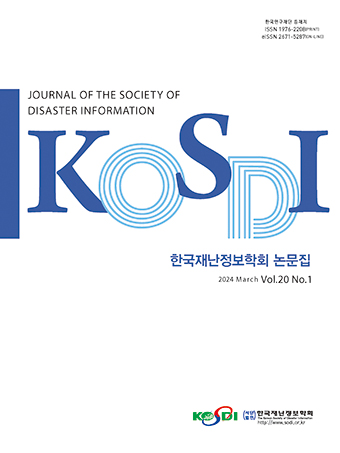Research Article
Abstract
References
Information
Purpose: To reduce the noise and vibration of reinforced concrete slab structures, the damping performance is to be performed experimentally after installing hollow core or filling it with liquid. Method: Using the hollow rate as an experimental variable, the damping ratio and stiffness of each test specimen at impact load are obtained to determine the difference between the damping ratio and stiffness of the numerical analysis. In addition, the damping effects are reviewed by comparing the difference in the damping ratio and stiffness of a test specimen filled with liquid 50% of the study. Results: Since the difference in resistance between a specimen with or without hollow core is 5%, it is judged that there is no structural problem, and the injection of liquid into the hollow core can increase the damping ratio, which can reduce noise or vibration. Conclusion: At less than 20% of hollow rate, there was little damping effect, and at 30%, damping effect was found. However, if liquid is injected into the hollow core of the specimen, damping rate is shown to increase, and the injection of liquid into the hollow part is believed to reduce noise or vibration.
연구목적: 철근콘크리트 슬래브에 발생하는 소음 및 진동을 저감하기 위하여 중공부를 설치하거나 중공부에 액체를 채워 설치한 후 감쇠성능을 실험적으로 수행하고자 한다. 연구방법: 중공율을 실험 변수로 하여, 충격하중을 가했을 때 각 시험체의 감쇠율과 강성을 구하여 수치해석에 대한 감쇠율과 강성의 차이를 알아낸다. 또한, 중공부의 50%를 액체로 채운 시험체의 감쇠율과 강성의 차이를 비교하여 감쇠효과를 검토한다. 연구결과: 중공부가 있는 실험체와 없는 실험체의 내력의 차이는 5% 정도로 오차범위에 있으므로 구조적인 문제는 없는 것으로 판단되며, 중공부에 액체를 주입할 경우 감쇠율이 증가함으로 소음이나 진동도 저감할 수 있을 것으로 판단된다. 결론: 중공율이 20%이하에서는 감쇠효과가 거의 없고, 30%일 때 감쇠효과가 나타났다. 그러나, 실험체의 중공부에 액체를 주입하였을 경우는 감쇠율이 증가하는 것으로 나타남으로, 중공부에 액체를 주입하면 소음이나 진동의 감쇠효과를 얻을 수 있을 것으로 사료된다.
- Bang, J.D., Lee, B.S., Kim, S.Y., Chun, Y.S., Kim, H.J., Cho, W.J., Yoo, S.Y., Kim, O.H. (2013). A Study on the Direction of Technology Development for the Reduction of Heavy Floor Impact Sound in Apartment Houses. Korea Land & Housing Corporation Research Report, pp. 176-182.
- Chung, H.W., Gi, N.G., Song, M.J., Kim, S.W. (2002). “A Study on the Reduction Characteristics of Floor Impact Sound Insulation Due to the Ceiling Frame Structures in Apartment Houses.” Journal of the Korean Society of Noise and Vibration Engineering, Vol. 12, No. 8, pp. 573-580. 10.5050/KSNVN.2002.12.8.573
- Moon, J.H., Lee, L.H. (1995). “Analytical Method of Prestressed Concrete Members with Unbonded Tendons.” Journal of Computational Structural Engineering Institute of Korea, Vol. 8, pp. 75-86.
- Park, H.E., Kim, M.S., Lee, Y.H. (2014). “A Parametric Study of Deflection Analysis of the Prestressed Concrete One-Way Slab for Serviceability Assessment.” Journal of Computational Structural Engineering Institute of Korea, Vol. 27, No. 6, pp. 525-532. 10.7734/COSEIK.2014.27.6.525
- Park, Y.H., Jeong, H.D., Oh, H.J. (2003). “Floating Floor of Multi-Supporting System.” Journal of the Korean Society of Noise and Vibration Engineering’s Science and Technology, pp. 928-931.
- Yoon, J.C., Lee, C.J., Jang, S.Y., Choi, S.H., Park, S.H., Jung, H.S. (2018). “Analysis of Track-Bridge Interaction and Retrofit Design for Installation of CWR on Non-ballasted Railway Bridge.” Journal of Korean Society for Urban Railway, Vol. 6, No. 4, pp. 383-392. 10.24284/JKOSUR.2018.12.6.4.383
- Publisher :The Korean Society of Disaster Information
- Publisher(Ko) :한국재난정보학회
- Journal Title :Journal of the Society of Disaster Information
- Journal Title(Ko) :한국재난정보학회논문집
- Volume : 15
- No :2
- Pages :292-300
- DOI :https://doi.org/10.15683/kosdi.2019.06.30.292




 Journal of the Society of Disaster Information
Journal of the Society of Disaster Information







